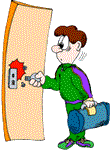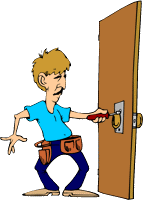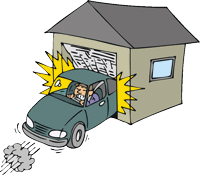 Knowing 'How To Fix a Door' can save you both 'time' and 'money'. Many times all a door needs is a little TLC to get it functioning properly again. Review the 'Troubleshooting Guide' below to figure out what your problem is and how hard it will be to fix.
Knowing 'How To Fix a Door' can save you both 'time' and 'money'. Many times all a door needs is a little TLC to get it functioning properly again. Review the 'Troubleshooting Guide' below to figure out what your problem is and how hard it will be to fix.
The door that is giving you trouble will likely be in one of these categories: (1) 'Entrance or exterior doors', (2) 'Garage doors', (3) 'Interior swinging' and 'Pocket doors' and (4) 'Closet doors'. Each of these pages has links to all the related topics for that door type.
Use the section on 'Troubleshooting Broken Doors' below to identify common door failures. Unsure of what type of door you are trying to fix? See the next section on 'Types of Doors in Your Home'.
Types of Doors in Your Home
You have several types of doors in your home. An average home can easily have between ten and twenty doors in it. Larger homes can have many more. Understanding the differrent types of doors will help you to isolate and fix your problem quickly.
- Exterior Doors - Any door that separates the inside of your home from the outside would be considered an exterior door. These are the doors that protect you from the elements.
-
- Entry Door - Most homes have at least two entry doors, a front door and a back door. Typically these are swinging doors that may or may not have glass panels in them. Thay can be made of wood or composite materials. These doors need to be made of insulating materials and usually require separate weatherstripping. Of all the doors in your home, your entry doors do the most work and have the highest expectations.
- Patio Door - A patio door as the name implies usually opens onto to patio, porch or deck. They can be a french style door or some other type of swinging door with a large glass lite in them. Double patio doors can have one or both panels that operate. Patio doors can have alignment and weatherstripping issues. Double swinging doors often have issues with the lock sets.
- Sliding Doors - More like a window than a door, sliding glass doors are used for access to outside spaces. Like a patio door they often open onto a deck or porch. A sliding glass door usually has one fixed panel and one moving panel, although other configurations are possible, including doors with three panels. The panel that opens has rollers that follow a track on the top and bottom of the door. Problems with the door staying on the track, noisy and sticking rollers and latches that don't lock are some of the problems that you can encounter.
- Garage Doors - This is the biggest door in your house. It is also one of the most complicated. Since garage doors are heavy they use springs to help lift the weight. Add to that the use of garage door openers and you have a potential for quite a few problems.
- Interior Doors - No mystery here, if it is not keeping the cold and heat out, it is an interior door. Doors on the inside of the house are used for both privacy and concealment. Bath rooms and bedrooms obviously need privacy. Closet doors conceal things that we don't want to look at all the time.
- Swinging Doors - Bedroom, bathroom, sometimes closets, basements, dens and media rooms are all candidates for this type of door. A swinging door is your most common type of door and is used for any room that needs to have some level of privacy or concealment some or all of the time.
- Pocket Door - Pocket doors are used in lieu of swinging doors in situations where space is limited. A pocket door slides into the wall and can provide additional floor area, especially in tight places like bathrooms. They have special problems and needs.
- Sliding Doors - Interior sliding doors are used on closets. There are two or more leaves that slide along a track, providing access to the things inside of the closet.
- Bifold Doors - Bifold doors have been the popular choice for closet doors in the last few decades. They are inexpensive and easy to install. They have the advantage of being able to open up the entire width of a closet at the same time.
How To Fix a Door - Troubleshooting
Swinging Doors - Interior & Exterior
Door Won't Close
A door that won't close or refused to open can be very irritating. Putting your foot on the wall when you try to open the door or using your shoulder to close it are two obvious signs.
Couple of things to consider. Is it a wood door? See the next section on doors that rub or stick., it could be swollen from high humidity.
Another test to locate the problem would be lifting up on the door handle when you try to open or close it. Does it work easier when you do that? If so, the top hinge is loose or out of adjustment. This is an adjustment issue and can be fixed. See one of these articles, depending on which type of door are dealing with, 'Adjusting Interior Doors' and 'Adjusting Entry Doors'.
Door Rubs or Sticks in Frame
In years gone by this was a common problem with wood doors. Especially in areas that have high humidity during some seasons. The wood in the door and frame will swell and then the door won't close. When this is your problem it is most likely that the door sticks along the full length of the jamb. For instructions on this topic, see 'Sanding and Planing a Wood Door'.
When the door sticks, where does it stick at? A common location for any type of door is the upper corner of the strike side (the side with the door knob) of the door. When this happens it is most likely that the door is out of adjustment. This can be a simple fix if you follow the instructions found in the articles 'Adjusting Interior Doors' and 'Adjusting Entry Doors'.
Door Hinges Stick and Squeak
Do you have stiff squeaking door hinges? This problem can be annoying, and may ruin the hinges over time. The good news is that rusty squeaky hinges can be restored to good working order. On rare occasions you may need or want to replace them.
For a complete discussion on dealing with hinge issues, see the series of articles on 'Squeaky Door Hinges'. If you are sure you need to replace them, see the article 'Replacing Rusty Door Hinges'.
Door Does Not Latch Properly
Do you have trouble getting the door lock to latch properly when you close it? Do you need to lean on the door to get it to catch? Or does it pop open when you think it is closed? Worse yet, does the lock refuses to set, no matter what you do?
These are common problems with door locks. Most of the time the door lock gets all the blame for issues like this. Most of the time is is not the door lock's fault. Instead the fault often lies with the door or the way it is positioned in the frame. The problem may also be caused by the strike plate, a strike plate that is not positioned correctly may keep the lock from latching correctly.
The first and easiest thing to check is the adjustment of the door. For exterior doors see the article 'Adjusting Entry Doors'. Interior door adjustment is covered in the article 'Adjusting Interior Doors'.
Cold Air Coming In Around the Door
This is a common problem, especially in colder climates. When you put your hand by the edge of the door you can feel cold air. The colder it gets the colder the air feels. You may be able to feel the air around the entire perimeter of the door, or it may only be in certain spots. Another variation is cold air coming in at the bottom of the door.
There are two problems that can cause a door to have gaps. The first is the adjustment of the door. Even with the proper weatherstripping and poorly hung door will not seal properly. Adjusting the door can solve this problem. For information and instructions, see the article 'Adjusting Entry Doors'.
The other issue could be the weatherstripping, it may need to be replaced, see the article 'Exterior Door Weather Stripping' for more information.
Garage Doors
Garage Door Will Not Go Up
Garage doors are very heavy and they use the internal tension of coiled springs to help offset the weight. When the springs break it is very difficult to lift the door. A broken spring is the likely cause of a door that you can't raise. See the article 'Garage Door Spring Repair' to help identify your problem.
Another potential cause would be a garage door that binds and sticks. This is usually an adjustment issue. For information on this subject, you can review the articles 'Adjusting a Garage Door' and 'Adjusting a Binding Garage Door'.
Garage Door Makes a Lot of Noise When it Operates
Garage doors are louder than most doors. They have several moving parts including hinges and rollers. Added to that, the tracks that support the door will flex when the door opens, creating further noise. Certain types of doors, such as all metal doors with no insulation, are especially loud.
With those comments aside, squeaky and sticking rollers and squeaky hinges can add to the noise level. See the articles on 'Lubricating Garage Door Rollers' and 'Oiling Garage Door Hinges' for some advice on how to cut down on the noise.
There is Daylight and Cold Air Coming In Around My Garage Door
If you have an attached garage, you probably don't want a lot of hot or cold air coming in around the door. Even if you garage is not conditioned space, you get some passive heating and cooling from your home. Why waste that? There are two key reasons why you have gaps around your garage door, (1) a door that is out of adjustment, (2) worn or missing weatherstripping.
For information on fixing the weatherstripping on your garage door, see the article 'Garage Door Weatherstripping'. The article 'Adjusting a Garage Door' discusses what you need to know about getting your door properly aligned.
Door Topics
Door Frame Repair
 Who's the Trouble Maker, the Door or the Frame? When a door won't close correctly it may be rubbing on or hitting the frame. Is it the frame that is the problem? Occasionally. Often it is the door itself that needs adjusting. Follow the above link to see what can be done with a door that won't close correctly. You may be pleasantly surprised by how easy it can be to adjust a door.
Who's the Trouble Maker, the Door or the Frame? When a door won't close correctly it may be rubbing on or hitting the frame. Is it the frame that is the problem? Occasionally. Often it is the door itself that needs adjusting. Follow the above link to see what can be done with a door that won't close correctly. You may be pleasantly surprised by how easy it can be to adjust a door.
The top hinge on any door does most of the work. It is also the hinge that is most likely to loosen up. There are ways to help it out. One long screw into the framing behind the top hinge can work wonders.
Entry Door Repair
Doorbell Rings, Which Door Do Your Head For? Homeowners and builders alike spend the most money on the front door. It makes a statement about the home and is the first thing visitors see. In addition, it is needed to keep the elements out. Locks and weather stripping are two key components on a front door. Follow the link above to learn what you need to do with entrance doors. It will help you keep your front and other entrance doors in good working order.
Interior Swinging Doors
Interior Doors are the plentiful in your home. These are easier to repair when compared to entrance doors, but there are more of them. Many times all that is needed is some adjustment, it may not be that hard. Follow the link above for information. It will help you deal with this type of door.
Closet Doors
I recently toured a couple of homes designed by Frank Lloyd Wright. Great architecture but not always practical. One key feature, he refused to design closets into his homes. Something about clutter. My opinion there are a lot of things you would rather have in a closet.
In recent decades the bifold door has taken center stage for closets, although, sliding doors are still common. Learn how they work and what you can do to repair them by following the above link.
Pocket Doors
A less common, but very useful door is a pocket door. They are often used when space is tight. They disappear into the wall, is that great or what? They do have some unique problems. See the article on for the special problems with this type of door.
Garage Doors
 What's the Biggest Door You Have? Of course I am talking about the garage door. It is the biggest, the heaviest and has the most moving parts. Things can break and get out of adjustment. You may have a garage door operator that can act up as well. For information on garage doors, follow the link above. This will help you deal with the problems you are having with your garage door.
What's the Biggest Door You Have? Of course I am talking about the garage door. It is the biggest, the heaviest and has the most moving parts. Things can break and get out of adjustment. You may have a garage door operator that can act up as well. For information on garage doors, follow the link above. This will help you deal with the problems you are having with your garage door.
It does not matter whether you use your garage for the car, an entrance or a storage facility. You still want the door to work properly. You can make garage door repairs without taking the door down. Check out the information before you call a serviceman.
Door Repairs the Safe Way
The main safety concern with door repair is the use of tools. Make sure you are familiar with safe practices for the tools you use. Another concern is the weight, make sure you are physically able to wrestle with a heavy door. There are special safety concerns for garage doors, take note of these in the garage door articles. Getting help is always a good idea. Check the Safety Links page for guidelines on safe practices.
Tools
You will need standard tools, screwdrivers and chisels are the most common items. Power tools like a battery drill and a sawzall may be needed. Check the tool requirements for the individual repairs for more information on the needed tools.
How To Fix a Door - Summary
Can you make your own door repair? In most situations, the answer is Yes! Make sure you are familiar with the steps involved. Troubleshoot the problem to make sure you are focusing on the right problem. Obtain the materials and tools required before you start. Follow the steps and take your time and you will be successful. Do something you want to with the money you save.
Recently, two of the doors in my house quit working on the same day. Odd. My four year old grandson found a screwdriver and managed to remove the bottom hinges off the bedroom and bathroom doors.
He put the bedroom door hinge back on, unfortunately it was backwards. For the bathroom door, he got the hinge on correctly, but could only get the screws back in part way. This was not too difficult to fix and I was impressed by his display of mechanical ability.

